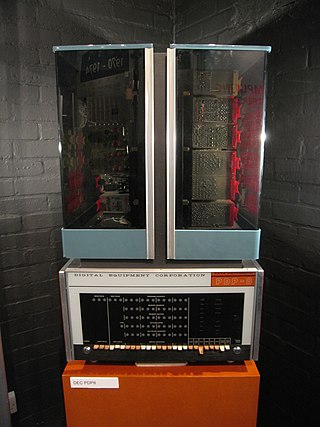
In programming and information security, a buffer overflow or buffer overrun is an anomaly whereby a program writes data to a buffer beyond the buffer's allocated memory, overwriting adjacent memory locations.

In computing, floating-point arithmetic (FP) is arithmetic that represents subsets of real numbers using an integer with a fixed precision, called the significand, scaled by an integer exponent of a fixed base. Numbers of this form are called floating-point numbers. For example, 12.345 is a floating-point number in base ten with five digits of precision:
In computer science, a memory leak is a type of resource leak that occurs when a computer program incorrectly manages memory allocations in a way that memory which is no longer needed is not released. A memory leak may also happen when an object is stored in memory but cannot be accessed by the running code. A memory leak has symptoms similar to a number of other problems and generally can only be diagnosed by a programmer with access to the program's source code.

The PDP-8 is a family of 12-bit minicomputers that was produced by Digital Equipment Corporation (DEC). It was the first commercially successful minicomputer, with over 50,000 units being sold over the model's lifetime. Its basic design follows the pioneering LINC but has a smaller instruction set, which is an expanded version of the PDP-5 instruction set. Similar machines from DEC are the PDP-12 which is a modernized version of the PDP-8 and LINC concepts, and the PDP-14 industrial controller system.
In computer science, syntactic sugar is syntax within a programming language that is designed to make things easier to read or to express. It makes the language "sweeter" for human use: things can be expressed more clearly, more concisely, or in an alternative style that some may prefer. Syntactic sugar is usually a shorthand for a common operation that could also be expressed in an alternate, more verbose, form: The programmer has a choice of whether to use the shorter form or the longer form, but will usually use the shorter form since it is shorter and easier to type and read.
A software bug is an error, flaw or fault in the design, development, or operation of computer software that causes it to produce an incorrect or unexpected result, or to behave in unintended ways. The process of finding and correcting bugs is termed "debugging" and often uses formal techniques or tools to pinpoint bugs. Since the 1950s, some computer systems have been designed to detect or auto-correct various software errors during operations.
A sanity check or sanity test is a basic test to quickly evaluate whether a claim or the result of a calculation can possibly be true. It is a simple check to see if the produced material is rational. The point of a sanity test is to rule out certain classes of obviously false results, not to catch every possible error. A rule-of-thumb or back-of-the-envelope calculation may be checked to perform the test. The advantage of performing an initial sanity test is that of speedily evaluating basic function.
In computing, an optimizing compiler is a compiler that tries to minimize or maximize some attributes of an executable computer program. Common requirements are to minimize a program's execution time, memory footprint, storage size, and power consumption.
In computer programming, an infinite loop is a sequence of instructions that, as written, will continue endlessly, unless an external intervention occurs. It may be intentional.
In computing and computer programming, exception handling is the process of responding to the occurrence of exceptions – anomalous or exceptional conditions requiring special processing – during the execution of a program. In general, an exception breaks the normal flow of execution and executes a pre-registered exception handler; the details of how this is done depend on whether it is a hardware or software exception and how the software exception is implemented.
In computer science, program analysis is the process of automatically analyzing the behavior of computer programs regarding a property such as correctness, robustness, safety and liveness. Program analysis focuses on two major areas: program optimization and program correctness. The first focuses on improving the program’s performance while reducing the resource usage while the latter focuses on ensuring that the program does what it is supposed to do.
In computer programming, a type system is a logical system comprising a set of rules that assigns a property called a type to every term. Usually the terms are various language constructs of a computer program, such as variables, expressions, functions, or modules. A type system dictates the operations that can be performed on a term. For variables, the type system determines the allowed values of that term. Type systems formalize and enforce the otherwise implicit categories the programmer uses for algebraic data types, data structures, or other components.
In computer science, program optimization, code optimization, or software optimization is the process of modifying a software system to make some aspect of it work more efficiently or use fewer resources. In general, a computer program may be optimized so that it executes more rapidly, or to make it capable of operating with less memory storage or other resources, or draw less power.

In computer science, conditionals are programming language commands for handling decisions. Specifically, conditionals perform different computations or actions depending on whether a programmer-defined Boolean condition evaluates to true or false. In terms of control flow, the decision is always achieved by selectively altering the control flow based on some condition . Although dynamic dispatch is not usually classified as a conditional construct, it is another way to select between alternatives at runtime. Conditional statements are the checkpoints in the programe that determines behaviour according to situation.
In computer programming, undefined behavior (UB) is the result of executing a program whose behavior is prescribed to be unpredictable, in the language specification to which the computer code adheres. This is different from unspecified behavior, for which the language specification does not prescribe a result, and implementation-defined behavior that defers to the documentation of another component of the platform.
In computer systems programming, an interrupt handler, also known as an interrupt service routine or ISR, is a special block of code associated with a specific interrupt condition. Interrupt handlers are initiated by hardware interrupts, software interrupt instructions, or software exceptions, and are used for implementing device drivers or transitions between protected modes of operation, such as system calls.
Fault tolerance is the resilient property that enables a system to continue operating properly in the event of failure or major dysfunction in one or more of its components. If its operating quality decreases at all, the decrease is proportional to the severity of the failure, as compared to a naively designed system, in which even a small failure can lead to total breakdown. Fault tolerance is particularly sought after in high-availability, mission-critical, or even life-critical systems. The ability of maintaining functionality when portions of a system break down is referred to as graceful degradation.

In computer programming, an integer overflow occurs when an arithmetic operation attempts to create a numeric value that is outside of the range that can be represented with a given number of digits – either higher than the maximum or lower than the minimum representable value.
In computer programming and software development, debugging is the process of finding and resolving bugs within computer programs, software, or systems.
In computer programming, several language mechanisms exist for exception handling. The term exception is typically used to denote a data structure storing information about an exceptional condition. One mechanism to transfer control, or raise an exception, is known as a throw; the exception is said to be thrown. Execution is transferred to a catch.




